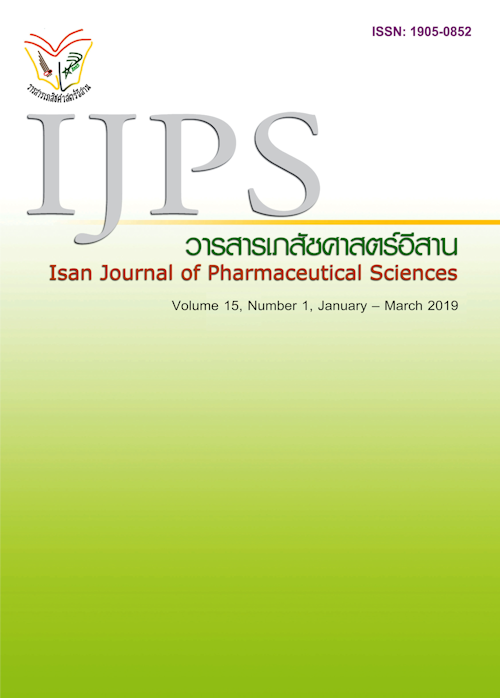Effect of Antibiotic Education by Using Face to Face Communication, Printed Materials, and Folk Media to People at Ban Nong-Tae Maha Sarakham Province
Main Article Content
Abstract
Introduction: Irrational use of antibiotics is a major cause of antimicrobial resistance. Health education with a simple and comprehensive media is necessary to support the right perception on antibiotic use in the community. Methods: This quasi-experimental study aimed to evaluate the effect of antibiotic education by using face-to-face communication, printed media and folk media. Samples were 63 people as the representatives of 63 households of Nong-tae village, Maha Sarakham Province. They were divided into 2 groups; Group I: 23 people who given two methods of antibiotic education; face-to-face and printed media by research team and Group II: 40 participants who given three methods; face-to-face communication, printed materials and folk media. Folk media content was participatory planned by health volunteers and by students for their performance in the folk song and media. Data collection was done within 6 months (September 2011 – February 2012). Results: Participants’ antibiotic knowledge was significantly increased after receiving antibiotic education (9.87±1.55 และ 11.65± 1.50, p<0.001). Three of 16 knowledge items showed the increase of the correct answerer proportion. Three conditions that showed increasing scores were common cold-URI, diarrhea, and uterus inflammation. For Group II, with 3 methods they showed the higher knowledge score after receiving antibiotic education (8.28±2.64 และ 12.55± 1.50, p<0.001). Nine of 16 items were improved and all four conditions of antibiotic use, the knowledge score were significantly improved. Sixteen people who participated in the folk media performance gave the high score of satisfaction on their participation. Conclusion: Antibiotic education with three methods; face-to-face communication, printed media and folk media could enhance the knowledge of the rational use of antibiotics. Three variety methods showed the positive synergistic effect on antibiotic knowledge of people in the community.
Article Details
In the case that some parts are used by others The author must Confirm that obtaining permission to use some of the original authors. And must attach evidence That the permission has been included
References
Cohen, J. A power primer. Psychological Bulletin 1992, 112,115-159.
Chattraporn Mutjupa. Effects of education in Antibiotic use on people, Ban Makok community, Maha Sarakham Province. Thesis in Bachelor Degree of Pharmacy, Mahasarakham University, 2009.
Chetley A, Hardon A, Hodgkin C, Haaland A, and Fresle D. How to improve the use of medicines by consumers. Geneva: World Health Organization; 2007.
Komatra Chuengsatiansup, Luechai Sringanyuang, Wichit Paonil. Medicine and Community: Social and Cultural dimension. Nonthaburi, Nangsuedeewan Company, Ltd. 2007: p 50-78.
Kornkaew Chanthapasa. Behavior of antibiotic use for symptomatic treatment of uterus inflammation Rural Esarn Female: Definition and related factors. Thesis in Bachelor degree of Pharmacy, Khon Kaen: Faculty of Pharmaceutical Sciences Khon Kaen University; 2009.
Luechai Sringanyuang. Uterus Kabur and Drug use in Rural Esarn Female. Health System Research Institute, 1996; 4[1]: 61-66.
Nithima Sumpradit. Antibiotics Smart Use: Scaling up toward sustainability and new social norms (2011 – 2013) Nonthaburi: Health System Research Institute, 2009.
Nithima Sumpradit. Academic Review Report Lessons of antimicrobial resistance solution in other countries Nonthaburi: Health System Research Institute, 2009.
Noparat PaongThong. Effects of counseling for HIV-infected patients ar AIDs clinic, Raoi-et Hospital. Thesis in Bachelor Degree of Pharmacy, Mahasarakham University, 2009.
Patinya Puyati, Tipaporn Kanjanarach. Prevalence and Pattern of Antibacterial Use in Upper Respiratory Tract Infections: A Study in Sub-district Health promoting hospitals of Buayai Contracted Unit of Primary Care in Nakhon Ratchasima Province. IJPS, March 2015; 11(Supplement): 253-260.
Pisonthi Chongtrakul. Smart Antibiotic Use. Bangkok: Usa Printing 2009.
Sasipong Tipratchadaporn. Outcomes of Antibiotic Smart Use Program in Governmental and Private Health Service Settings in PhannaNikhom, Sakon Nakhon, Proceeding in the 12th National Herbal Conference, 2-4 September, 2015 at Impact Maungthongthani, Nonthaburi Province.
Siritree Suttajit, Naruemol Boonsarn, Jutharat Srisuparang, Bulan Udomsri. A Full report of Relationship between antibiotic policy, antibiotic use and resistant rate in hospitals. National Antimicrobial Resistance Surveillance network. Thai Drug Watch. Thai Health Promotion Foundation; 2011.
Somsak Arparsrithongsakul. Community participation for preventing antibiotic sale in store of community, Maha Sarakham Province Health Consumer Protection Program; 2011.
Supatra Chadbunchachai, Arun Jirawatkul, P Loengenkasut, C Tontakulrat, T Prayulhong., et al. Information sources and Decision Making Process Regarding the Use of Drugs by the People in Northeastern Thailand: Case study in 4 Villages. Research and development Institute Khon Kaen: Khon-Kaen-Kam-Pim Press, 1990, p 55-92.
Surang Dejsirilert, Orathai Thongmali. Drug system situation in 2006. Antimicrobial resistance situation and antibiotic use problems: 3-4 May 2007, Bangkok, Thailand. Chulalongkorn University; 2007, p.6-11
Usa Sarnmano et al. Effects of individualized health education on knowledge and attitude of antiobiotic use in community. Thesis in Bachelor Degree of Pharmacy, Mahasarakham University, 2009.
World Health Organization. Containing antimicrobial resistance. Geneva: WHO April 2005.
Wibulpolprasert Suwit. Thailand Health Profile 2005-2007. Printing Press, The War Veterans Organization of Thailand. 2007.


